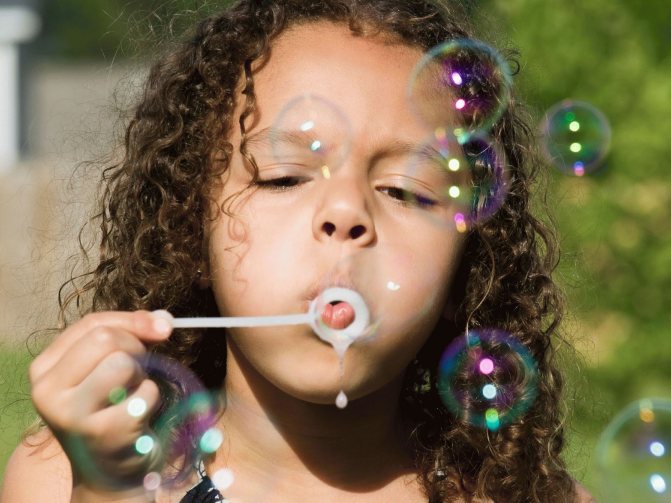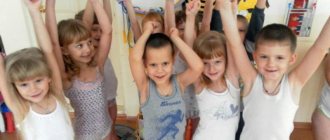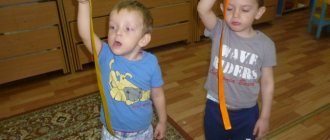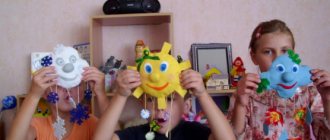Breathing exercises for preschool children
Breathing is the most important function of the body. An important place in physical culture is occupied by special breathing exercises, which provide complete drainage of the bronchi, cleanse the mucous membrane of the respiratory tract, and strengthen the respiratory muscles. Even the ancient eastern sages, the creators of various respiratory systems, attached great importance to breathing exercises. It was believed that in addition to oxygen supply, breathing also provided energy to the body. Proper breathing regulates the state of the human nervous system.
Recently, in many children's institutions, there has been an increase in the number of children with various developmental disorders, learning difficulties, and adaptation difficulties. Such children are disinhibited, often aggressive for no reason, and are unable to independently suppress negative emotions or control their soul and body. To overcome their existing disorders, one of the most important components is a system of breathing exercises, breathing exercises. Any person, be it a child or an adult, can do without food or water for some time, but without air he cannot live even ten minutes.
The habit of breathing through the mouth is harmful and leads to diseases of the thyroid gland and respiratory system. Nasal breathing protects the throat and lungs from cold air and dust, ventilates the lungs and middle ear cavity well, and has a beneficial effect on the blood vessels of the brain. In addition, such gymnastics significantly increases the strength of the protective mechanisms that protect the brain from insufficient blood supply.
Regular breathing exercises help to develop correct speech breathing with long, gradual inhalations and prevent respiratory diseases. Diseases such as rhinitis, nasopharyngitis, rhinosinusitis, sinusitis, chronic bronchitis, adenoiditis, nasal polyps often cause sound pronunciation in children, complicate the process of correct speech breathing, change the intonation color of the voice, and cause changes in the structure of the organs of articulation.
There are many methods of breathing exercises known (according to K. P. Buteyko, A. N. Strelnikova, according to the yoga system, etc.)
, but mechanically following any of them is not advisable.
The fitness of the respiratory muscles determines a person’s physical performance and endurance: as soon as an untrained person runs a few tens of meters, he begins to breathe rapidly and feel shortness of breath due to the poor development of the respiratory muscles. Trained people do not experience shortness of breath, and their breathing quickly calms down even after prolonged physical activity.
Regular breathing exercises will allow children not only to feel better, but also to conduct dialogue correctly using punctuation and expressiveness of speech. Because, often, children do not monitor their speech: they do not swallow drool, speak quickly, without emotions.
Also, many kindergartens have a swimming pool. And if we start morning exercises every day with breathing exercises, this will allow our children to breathe correctly when they swim.
When developing breathing exercises, I took into account:
- the effectiveness of each exercise for hardening and improving the health of children in a preschool institution;
— an accessible degree of difficulty of exercises for children of different ages;
- the degree of influence of exercises on strengthening the respiratory muscles, ventilation of all parts of the lungs, development of the upper respiratory tract, etc.
In order to systematically use breathing exercises, they should be included in complexes of health-improving gymnastics and physical education classes.
Approximate gymnastics complexes:
Let's listen to our breathing
Target:
teach children to listen to their breathing, determine the type of breathing, its depth, frequency and, based on these signs, the state of the body.
Starting position - standing, sitting, lying down (as convenient at the moment)
.
In complete silence, children listen to their own breathing and determine:
- what part of the body moves when inhaling and exhaling (stomach, chest, shoulders or all parts - wave-like)
;
- what is the breathing frequency: often inhale-exhale or calmly with a certain interval (automatic pause)
;
- quiet, inaudible breathing or noisy breathing.
This exercise can be done before or after physical activity, so that children learn to determine the state of the whole body by breathing.
Breathe quietly, calmly and smoothly
Starting position - standing, sitting, lying down (this depends on the previous physical activity)
. If you are sitting with your back straight, it is better to close your eyes.
Inhale slowly through your nose. When the chest begins to expand, stop inhaling and pause as long as you can. Then exhale smoothly through the nose (repeat 5–10 times)
.
The exercise is performed silently, smoothly, so that even a palm placed to the nose does not feel the stream of air when exhaling.
Balloon in the chest
(medium, costal breathing)
Starting position - lying, sitting, standing. Place your hands on the lower part of the ribs and concentrate on them.
Exhale slowly, evenly, squeezing the ribs of the chest with your hands.
1. Slowly inhale through your nose, your hands feel the expansion of your chest and slowly release the clamp.
2. As you exhale, the chest is again slowly pressed with both hands at the bottom of the ribs.
Repeat 6-10 times.
Balloon rises up (upper breathing)
Starting position - lying, sitting, standing. Place one hand between your collarbones and concentrate on them and your shoulders.
Inhale and exhale with a calm and smooth rise and fall of the collarbones and shoulders.
Repeat 4-8 times.
Wind
(cleansing, full breath)
Starting position - lying, sitting, standing. The torso is relaxed. Exhale completely through your nose, drawing in your stomach and chest. Take a full breath, protruding your stomach and chest ribs. Forcefully release the air through pursed lips with several abrupt exhalations.
Repeat 3-4 times.
Hedgehog
Turn your head left and right at the pace of movement. Simultaneously with each turn, inhale through the nose: short, noisy (like a hedgehog)
, with tension in the muscles of the entire nasopharynx
(the nostrils move and seem to connect, the neck tenses)
. Exhale softly, voluntarily, through half-open lips.
Repeat 4-8 times.
Lips “tube”
1. Exhale completely through the nose, drawing in the stomach and intercostal muscles.
2. Form your lips into a “tube” and sharply draw in air, filling all your lungs to capacity.
3. Make a swallowing movement (as if you are swallowing air)
.
4. Pause for 2-3 seconds, then raise your head up and exhale air through your nose smoothly and slowly.
Repeat 4-6 times.
Ears
Shaking your head left and right, take deep breaths. The shoulders remain motionless, but when the head is tilted to the right, the ears are as close to the shoulders as possible. Make sure that your torso does not turn when you tilt your head. Inhalations are performed with tension in the muscles of the entire nasopharynx. Exhalation is voluntary. Repeat 4-5 times.
Blowing soap bubbles
1. When tilting your head to your chest, inhale through your nose, straining the muscles of the nasopharynx.
2. Raise your head up and calmly exhale air through your nose, as if blowing soap bubbles.
3. Without lowering your head, inhale through your nose, straining the muscles of the nasopharynx.
4. Exhale calmly through the nose with your head bowed. Repeat 3-5 times.
Tongue "tube"
1. The lips are folded in a “tube”, as when pronouncing the sound “o”. Stick out your tongue and also fold it into a “tube”.
2. Slowly drawing in air through the “tube” of the tongue, fill all the lungs with it, inflating the stomach and ribs of the chest.
3. When you finish inhaling, close your mouth. Slowly lower your head until your chin touches your chest. Pause - 3-5 seconds.
4. Raise your head and calmly exhale air through your nose.
Pump
1. Bring your hands together in front of your chest, clenching your fists.
2. Bend forward and down and with each springy tilt take gusty breaths, as sharp and noisy as when inflating tires with a pump (5-7 springy bends and breaths)
.
3. Exhalation is voluntary.
Repeat 3 times.
Smelling flowers (exercises for younger children)
1. Hands in front of you, clenched into a fist, imagine that there is a chamomile in one hand and a dandelion in the other. On “one” - children smell chamomile, on “two” - they blow off a dandelion
2. Starting position - main stance. On “one” - children squat, collecting as many flowers as possible, on “two” - they sharply blow off all the flowers.
These exercises will allow children to breathe correctly during all physical activity and become resilient children!
Literature:
1. Gorbatenko O. F., Kardailskaya T. A., Popova G. P. Physical education and health work in preschool educational institutions: planning, classes, exercises, sports and leisure activities. — Volgograd: Teacher, 2008
2. Podolyanskaya E.I. Forms of health improvement for children 4–7 years old: kinesiological and breathing exercises, morning exercises. — Volgograd: Teacher, 2009
3. Yakovleva L., Yudina R. Preschool education. - 1997. - No. 2. - P. 14–20.
4. https://doshvozrast.ru/ozdorov/gimnastika10.htm
The importance of breathing exercises when working with preschoolers
Many preschool children have fragile immunity: they are susceptible to frequent respiratory diseases, suffer from a runny nose, and prolonged cough. And parents sometimes don’t even realize that the cause of this may be improper shallow breathing. In this case, inhalation and exhalation of air does not occur at full strength. As a result, there is no complete ventilation of the lungs, and the growing body lacks oxygen. The brain and other important organs suffer from this, all cells starve, weakening their barriers to harmful microorganisms.
In addition to frequent acute respiratory infections, a baby with a poorly developed respiratory system, as a rule, is pale, drowsy and slow. He gets used to breathing through his mouth and is not very developed physically - he has weak muscles.
The key goal of breathing exercises is to teach a preschooler to breathe correctly, and therefore improve his health. The lungs should fill as much as possible during inhalation, and the chest should expand. When exhaling, it is extremely important that all the air is released, otherwise the remaining air will limit the flow of new air in the required volume.
Along with this, there are also exercises, on the contrary, aimed at training fast breathing. They have their own benefits - they help strengthen the nasopharynx and larynx.
The importance of breathing exercises for preschoolers is very great:
- All cells of the body are saturated with oxygen, metabolic processes improve, and all organs begin to function fully. The child becomes less susceptible to respiratory diseases: the disease goes away faster, and the likelihood of developing complications is reduced.
- Exercises help in the fight against existing chronic diseases: asthma, sinusitis, problems with adenoids, etc.
- Speech breathing defects are corrected, the speech apparatus is strengthened, which helps eliminate speech therapy problems.
- Since the brain receives adequate oxygen supply, children become more efficient and active, and their intellect develops better.
- Physical development also improves. Physical education classes with proper breathing bring more benefits, the child develops muscles and a healthy complexion.
- Exercises teach preschoolers to control their breathing. As a result, the ability to control one’s own actions and to control one’s own actions is formed.
- Inhaling slowly promotes relaxation and calm (this is especially important for hyperactive children), helps fight anxiety, excessive irritability, and emotional fatigue.
Interestingly, breathing exercises have very few contraindications. For example, it is undesirable to perform gymnastics for children who have suffered injuries to the brain, spine, osteochondrosis of the cervicothoracic vertebral region, as well as high blood pressure (arterial, intraocular, intracranial).
If a child has asthma, the intensity of exercise should be discussed with the attending physician.
Rules for performing breathing exercises in preschool educational institutions
Conducting breathing exercises with preschoolers has certain nuances:
- The air in the room must be fresh, but not cold.
- It is very useful to do gymnastics outside. In addition to special play exercises, it is good to simply invite children to breathe deeply the fresh aroma of nature (for example, after rain), to notice how wonderful the flowers in the flowerbed smell, etc. This will not only strengthen the respiratory organs, but also enrich children’s ideas about the world around them. And after a walk in cold weather, you can intensively blow on your palms to warm them up (this is also a useful breathing exercise).
- Any exercise should not last more than 3 minutes.
- The muscles of the child’s body should not be tense.
- If your baby has a runny nose, you should clear your nasal passages before doing exercises.
- Exercises must certainly be regular, since the healing effect is observed after a long course.
- If a child is in a bad mood and is not inclined to exercise, then you should not force him to train. This will not bring any benefit, because a positive attitude is important. The teacher must show imagination so that the child himself wants to get involved in the activity.
- Gymnastics should not be performed immediately after eating, as this can lead to nausea and even vomiting. You need to pause for at least half an hour. It is also forbidden to do exercises on an empty stomach - the child may simply feel dizzy.
- In the process of performing gymnastics, you need to monitor the condition of preschoolers. If someone turns pale or blushes, closes his eyes, or begins to breathe quickly, then you should immediately offer this child to rest.
- The same exercise can become more difficult over time. For example, don’t just warm your hands after a walk - direct deep warm breath onto them, but accompany your actions with a drawn-out pronunciation of vowel sounds (“a”, “o”, “u”).
You can practice breathing exercises from the nursery group. For children 2–3 years old, this should be an extremely fun game in which the teacher participates along with preschoolers. First, you need to clearly explain to kids what breathing is. To do this, you can, for example, play with a dandelion in the kindergarten area. A deep exhalation, from which white fluffs fly away, is done first through the mouth and then through the nose.
To interest the youngest preschoolers in play exercises, the teacher suggests playing, transforming into someone or something: “Let you be pumps!” or “Imagine that your stomach is a balloon!”
Students in the middle group are already more independent and diligent. At this age, children need to be taught to listen to breathing, characterize its depth, strength (quiet or noisy), frequency, track where the air stream is directed, how the chest moves, etc. Breathing exercises become more complicated: turns to the left and right appear, competitive element.
In the senior preschool level, in addition to other exercises and games, you can already practice A. Strelnikova’s technique. After all, children, with the help of a teacher, consciously approach the performance of useful tasks.
Breathing exercises class in kindergarten
When conducting breathing exercises in preschool educational institutions, the age characteristics of preschoolers and the level of difficulty of the exercises should be taken into account. Completing a set of 5–7 tasks takes 8–12 minutes. Stages of gymnastics:
- Introductory part: exercises that do not require complex combinations of movements, inhale and exhale at a normal pace - 2-3 minutes.
- Main part: tasks with a combination of inhalation-exhalation tempo and complicated movements, as well as changing body posture - 4-5 minutes.
- Final part: exercises to restore the rhythm of breathing, static body position - 2-3 minutes.
The ability to breathe correctly is extremely important for a child. After all, this is not only a necessary basis for good health, but also a condition for full mental development. The teacher’s task is to put breathing exercises into an entertaining game form. Funny poems and interesting manuals will come to the rescue. Doing simple exercises will gradually become a habit for preschoolers and will make spending time in kindergarten even more fun.
SOURCE: https://melkie.net/zanyatiya-s-detmi/dyihatelnaya-gimnastika-v-detskom-sadu.html
What is speech breathing
Speech breathing is the basis of speech. It can be compared to the power that a person uses when exhaling to produce sounds. Speech breathing can be controlled and trained. It affects how strong, loud and clear a person's voice is.

Breathing is important for speech
Development of speech breathing
If a person is not able to regulate breathing for life, then speech breathing can be regulated. To develop it and better control it, you need to do special exercises. The system of these exercises is aimed at teaching the child to inhale a portion of air sufficient to pronounce three phrases. Then (also through the mouth) inhale an additional portion of air to pronounce the following phrases.
Exercises for the development of speech breathing in preschool educational institutions and at home:
- blow on a dandelion (or imitate it);
- blow bubbles;
- blow on a turntable;
- inflate balloons;
- blow a whistle;
- play the pipe;
- whistle;
- blow and move the balloon;
- blow and roll a simple pencil on the table;
- exhaling through your mouth, melt the snowball on your hand.

Voice depends on breathing
It is necessary to increase the duration of exercises gradually so that the child’s body has time to adapt. The workout begins with a small number of repetitions with one approach, then increasing the load. If logorhythmics is performed regularly, then articulation will improve day by day.
If a child stutters or, when speaking longer phrases, begins to swallow them, rushes and has the feeling that he is suffocating, then most likely his respiratory apparatus is poorly developed. This may be a feature of the body, be a consequence of insufficient training or the presence of diseases (for example, sinusitis or adenoids).
Note! It is necessary to strengthen the baby’s body, improve health, determine the source of the problem and regularly train the breathing apparatus. Singing, which strengthens the entire respiratory system, helps to cope perfectly with this problem.
What to do if a 3-year-old child speaks only the first syllables of words
In order for the exhalation to be long and forceful, it is necessary to perform an articulatory set of exercises as a basis:
- Inhale air through your mouth with a barely noticeable smile on your lips, and also exhale through your mouth, accompanying this with sound.
- Do the exercise “Hills and ravines”. His scheme is for the child to round his belly while inhaling air. The stomach should become convex.
Note! The correct method of execution is when the shoulders do not rise when inhaling. On the exhale, on the contrary, the stomach should be drawn in as much as possible.
Types of breathing exercises practiced in kindergarten
In a preschool educational institution (DOU), the following main types of breathing exercises can be distinguished.
Breathing games
The teacher not only invites preschoolers to perform certain useful exercises, but presents them in the form of an exciting game. There are many options here. For example, kids create their own orchestra - some “musicians” are given pipes, others are given harmonicas. As a result, the guys have an interesting time while strengthening their breathing.
Active children will certainly enjoy “Air Football”, in which, in order to score a goal, you don’t need to hit the ball, but blow on it, driving it into the goal. Little creative types will find it interesting to breathe heavily on the glass or mirror so that it fogs up. Then you can draw any picture on the surface.
Children always enjoy playing in the snow - they put snowflakes made from small balls of cotton wool on their palms and blow them off. In the same way, you can arrange leaf fall or the flight of paper butterflies.
A good idea is to have fun competitions, such as “Whose locomotive makes the loudest noise?” Each child receives an empty bottle and blows into it with all his might so that a whistle is heard. Children are guaranteed a lot of positive emotions.
The teacher can intrigue the children by offering them magic boxes (these can be plastic containers from Kinder surprises). Each one is filled with something special: orange peels, dry mint leaves, vanillin, etc. The task of preschoolers is to determine what kind of aroma it is: to do this, they need to inhale the air deeply through their nose.
A variety of ideas for games can be implemented while walking. For example, organize a bubble festival. All children love this activity, and at the same time it strengthens the respiratory system.
Card file of speech motor exercises for preschoolers
Play is the main activity of preschoolers, regardless of their age: junior, middle or senior. Therefore, exercises should be carried out in a playful way, be exciting, emotionally charged, and arouse interest.
Two basic speech exercises for a child:
- Exercise "Giraffes". Children stretch their noses to the ceiling, stretching their necks. They remain in this position for some time, then return to their original position.
- Exercise "Pebbles". Preschoolers imitate how they use both hands to collect small pebbles in both hands separately. Keep your fists clenched for a while, then relax your hands, as if scattering pebbles.







